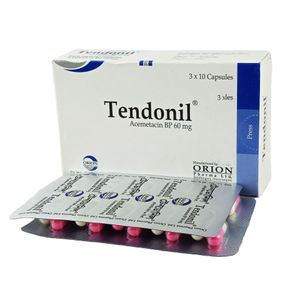Tendonil Uses, Dosage, Side Effects and more
Tendonil is a non-steroidal anti-inflammatory drug. It is also known as an NSAID. It works by blocking a substance in the body called cyclooxygenase (also known as COX) which is involved in the production of certain irritant chemicals in response to injury or rheumatic disease. By blocking the action of COX, Tendonil reduces the symptoms of pain and inflammation.
The effect of acemetacin causes a weak reduction of prostaglandin synthesis which generates an anti-inflammatory and analgesic effect. The weak inhibition of prostaglandin reduces significantly the damage caused in the mucous membrane of the gastrointestinal tract. Studies have shown that acemetacin strongly inhibits the release of histamine from mast cells and the generation of hyperthermia. Tendonil effect also causes changes in systolic and diastolic blood pressure as well as inhibition of platelet aggregation.

| Attribute | Details |
|---|---|
| Trade Name | Tendonil |
| Generic | Acemetacin |
| Acemetacin Other Names | Acemetacin, Acemetacina, Acemetacine, Acemetacinum, indometacin carboxymethyl ester, indometacin glycolic ester, indomethacin carboxymethyl ester, indomethacin glycolic ester |
| Weight | 60mg |
| Type | Capsule |
| Formula | C21H18ClNO6 |
| Weight | Average: 415.83 Monoisotopic: 415.082265 |
| Protein binding | Acemetacin is found highly bound to plasma proteins, reaching a percentage higher than 90% of the administered dose. |
| Groups | Approved, Investigational |
| Therapeutic Class | Non-steroidal Anti-inflammatory Drugs (NSAIDs) |
| Manufacturer | Orion Pharma Ltd |
| Available Country | Bangladesh |
| Last Updated: | January 7, 2025 at 1:49 am |
Uses
Tendonil is used for pain & inflammation associated with musculoskeletal & joint disorders. For example: Rheumatoid arthritis, Osteoarthritis, Low back pain. Also used for the pain after an operation.
Tendonil is also used to associated treatment for these conditions: Pain, Inflammatory
How Tendonil works
Tendonil is a non-selective inhibitor of the production of pro-inflammatory mediators derived from the action of the enzyme COX. COX is essential for the synthesis of prostaglandin E2 and F2 which are molecules derived from fatty acids and stored in the cell membrane. Acetometacine is metabolized and forms its major metabolite indometacin which is also a non-selective inhibitor of COX and exhibits the capacity to inhibit the motility of polymorphonuclear leukocytes and decreased cerebral flow by modulating the nitric oxide pathway and vasoconstriction.
Dosage
The recommended starting dose is 120mg/day in divided doses, increasing to 180mg/day in divided doses, depending on patient response.
For the treatment of elderly patients, adjustment of dosage is not normally required. However, NSAIDs should be used with particular care in older patients who may be more prone to adverse reactions. Tendonil should be taken with food, milk or an antacid to reduce the possibility of gastro-intestinal disturbance.
How Long Does It Take to Work?
How Long Does It Take to Work? see here Tendonil
Side Effects
Common side effects include anorexia, nausea, vomiting, diarrhoea and constipation, peptic ulceration, headache, dizziness & vertigo. Rarely confusion, depressed mood, oedema, chest pain, blood urea elevation are found.
Toxicity
The pharmacological activity of acemetacin causes blockage of prostaglandin synthesis. Prostaglandin is one of the mediators of renal blood flow and glomerular filtration thus, acemetacin causes a decreased renal function, transient renal insufficiency, interstitial nephritis and papillary necrosis especially in elderly patients, patients with congestive heart failure, hepatic cirrhosis and impaired renal function.
Precaution
Caution should be taken in elderly people, history of disorders affecting the stomach or intestines, inflammatory bowel disease such as Crohn's disease or ulcerative colitis, kidney disease, liver disease, heart failure.
Interaction
Tendonil reduces the antihypertensive effect of b-blockers. Increase risk of convulsion when used with quinolone. Concurrent use with aspirin, NSAIDs or corticosteroids may increase risk of GI bleeding. Increased risk of methotrexate toxicity when used together.
Volume of Distribution
The apparent volume of distribution of acemetacin is in a range of 0.5-0.7 L/kg.
Elimination Route
After 8 days of oral administration twice daily of acemetacin there was an age-dependant Cmax of 276.8 ng/ml in elderly compared to 187 ng/ml for younger individuals. There was also a Tmax of 2.5 h and AUC in a range of 483-712 ng h/ml. The bioavailability of acemetacin after repeated doses is aproximately 66% in plasma and 64% in urine.
Half Life
The elimination half-life of acemetacin after steady-state is 4.5 hours.
Clearance
Intravenous administration of acemetacin in healthy subjects reported a clearance rate of 4.59 ml min/kg.
Elimination Route
The elimination of acemetacin is divided in renal elimination that covers 40% of the complete administered dose and the restant 60% is excreted in feces.
Pregnancy & Breastfeeding use
The safety of this medicine in human pregnancy and lactation has not been established. Some animal reproduction studies showed some toxic/ teratogenic effects on fetus. Therefore, use of this drug during pregnancy and lactation period is not recommended.
Contraindication
Tendonil is contraindicated to known hypersensitivity to Tendonil or Indomethacin; peptic ulcer; safety in children is not established.
Storage Condition
Store in a cool and dry place, below 25℃ and away from light.



